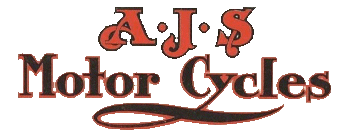

New front mudguards and larger exhaust pipes are the most obvious changes on the 7 h.p. A.J.S.
A standard sports model 2¾ h.p. A.J.S. Fitted with kick-starter and footrests, this is an ideal fast touring machine.
A new frame giving lower and more amidships seating is a feature of the 2¾ h.p. A.J.S. Excellent guards and internal expanding brakes are fitted to the tcuring model.
ONE of the most popular sidecar outfits on the market - the 7 h.p. A.J.S. - has been modified in one or two important points. Chief of these is the fitting of a shock absorber on the engine shaft. This device consists of a iioating sprocket prevented from rotational movement by a face cam splined on to the crankshaft, and held in engagement by a powerful coil spring. Any sudden shock causes the sprocket to ride slightly on the spring-loaded cam. A new front mudguard passes between the fork members and the valances splay outwards below the head; this guard, while being equally effective, provides a better air flow to the cylinders. Instead of the separate magneto and dynamo the Lucas Magdyno is now standardised, and larger exhaust pipes held by a very ingenious external clamping nut are employed. Further modifications consist of improved roller bearing big ends and fabric inserts in the clutch instead of cork. The seating accommodation of the sidecar has also been slightly changed, the slope of the seat and backrest being modified to give a more natural riding position.
The Brooks B500 saddle is of course retained, and this does not interfere with the fitting of pannier toolbags.
The Improved Light Solo Models.
Solo riders will be charmed with the latest 2¾ h.p. A.J.S., which is one of the neatest and best carried-out medium-weight machines that we have examined. It is to be listed in three models, all at the attractive figure of £85. The average solo rider will probably choose the standard sporting model, and this we shall take as a basis for description. The engine (74x81 mm. bore and stroke = 348 c.c.) differs little from the already well-known 2¼ h.p. side-by-side valve engine. Plain crankshaft bearings are employed, but a double row roller bearing is fitted to the big end. A cast-iron piston, with four narrow piston rings, is used and, except for details, the cylinder head is a replica of that of the 7 h.p. model.
Following A.J.S. practice, the head is held down by a cross-bar and two long bolts, and is stayed to the saddle tube by a clip and bar. Transmission is, by chain throughout, a shock absorber being fitted on the engine-shaft. Three speeds are provided by the countershaft gear box, and a three-plate cork insert clutch is mounted on the gear mainshaft. Contrary to usual practice, a kick-starter is fitted to the standard sports model. Both front and rear brakes are of the internal expanding type, and the rear wheel is easily and quickly detachable without disturbing the brake or chain; 26x2¼ in. Dunlop heavy tyres are fitted. The frame is particularly neat and light, and provides a low saddle position well forward of the rear wheel; while another important point lies in the fact that the engine plates are secured to the frame by two bolts to both down and saddle tubes.
A very simple and ingenious adjustment is provided for the footrests, the bosses of which are drifted so as to form an internal octagonal star, which may be mounted on the square section cross-bar in a number of positions.
Front suspension is by the latest type of Druid fork, which is particularly interesting, in that it provides a compound action, yet all the springs are carried between the fork blades, so as to be out...
continued on page 663
The MotorCycle, November 24th, 1921
If you have a query or information about AJS motorcycles please contact us